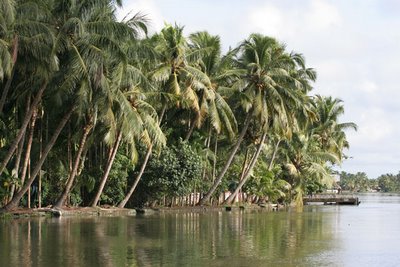
 Another interesting thing I saw on the road was workers installing conduit for data cables. If you look in the background, you'll see tea bushes. India's past source of wealth meeting with it's current/future. Wow.
Another interesting thing I saw on the road was workers installing conduit for data cables. If you look in the background, you'll see tea bushes. India's past source of wealth meeting with it's current/future. Wow.
Speaking of wealth, there are some pretty big houses in certain parts of Karala. I asked my driver where the money was coming from and he told me that the big houses belong to people who work on oil rigs for 6 months at a time.

 This is the best photo I could get of a prototypical Karala style roof. The large vents on the sides are to let cooking smoke out, as well as to help ventilate the house ( It's very humid in Karala)
This is the best photo I could get of a prototypical Karala style roof. The large vents on the sides are to let cooking smoke out, as well as to help ventilate the house ( It's very humid in Karala) Next on my program was a Karala "back water" tour in a houseboat. The house boats are built on the hulls of old rice boats. I asked the pilot of my boat how old the hull was and he told me it was from the 40's. The hull was still in great shape even though it was all wood. It seemed to be impregnated with some sort of oil or pitch. House boat tours are a very touristy thing to do. I didn't see any locals living in houseboats. The pilot of my boat said they do, in some areas. Touristy or not, boats are the only way to see this unique part of south India. The water is the only access to most of villages.
Next on my program was a Karala "back water" tour in a houseboat. The house boats are built on the hulls of old rice boats. I asked the pilot of my boat how old the hull was and he told me it was from the 40's. The hull was still in great shape even though it was all wood. It seemed to be impregnated with some sort of oil or pitch. House boat tours are a very touristy thing to do. I didn't see any locals living in houseboats. The pilot of my boat said they do, in some areas. Touristy or not, boats are the only way to see this unique part of south India. The water is the only access to most of villages. The cook on my boat was fantastic. The food on the boat was by far the best I've had since arriving in India. Karala style cooking uses coconut and coconut oil in the cooking as well as a lot of fish, which adds distinctive flavors relative to the other south Indian food. I really can't figure out why all the Indian places in the US serve only north Indian stuff. Karala style food is way better!
The cook on my boat was fantastic. The food on the boat was by far the best I've had since arriving in India. Karala style cooking uses coconut and coconut oil in the cooking as well as a lot of fish, which adds distinctive flavors relative to the other south Indian food. I really can't figure out why all the Indian places in the US serve only north Indian stuff. Karala style food is way better!
The milky looking drink you see to the left is Toddy. It's a young fermented drink made from the sap of a particular palm tree. By young, I mean YOUNG. They make it in the morning to be consumed the same day. This was lunch and the Toddy I'm drinking was made that very morning. It had that "still fermenting" smell and some mild natural carbonation. But boy, did it taste good! Like a not so sweet white wine with a mild coco-nutty flavor. I'm going to have to get Toddy at least one more time before I leave India.

The back water villages/ rice paddies are a model of Indian ingenuity. What the villagers have done over the years is create a system of levies which hold the water out from the shallows of the lake and create rice paddys. The village itself is on the levy. Think of it this way, if the water is the street, and the levy the front yard, the rice paddy is the houses back yard. There are no neighboring houses to the back. The top of the levy serves as a sidewalk where people can walk even if the paddies are flooded.
It's such a clever system. First of all, the villagers gain the use of the rich soil at the bottom of the lake. Second, all they need to do to flood the paddies is open a lock (They are below the lakes level). I also saw a situation where they were pumping lake sediment into the paddies to build them up/add nutrients.
Like most poor Indians, people in the Karala back waters use the nearest water source for everything: bathing, cloths washing, dish washing... sometimes even drinking. if there is no well near)



At one point the crew stopped the boat so they could collect some laundry they'd left with one of the villagers for washing. I was immediately swarmed by a group of kids who insisted that I take their photos. They also asked for pens and other school stuff. As we passed a snack shack, they begged me for chocolate. (no cash... these kids were not "beggars", just poor village kids)



A group family shot.

No comments:
Post a Comment